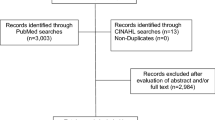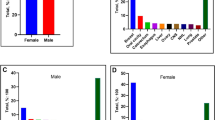Abstract
Background
Two factors jointly account for significant gaps in access to health care among immigrants who are present in the U.S.—legal status, and length of residence. The objective of this study is to examine the association between citizenship and length of residence in the U.S. and cancer screening (breast, cervical, and colorectal) among women.
Methods
We analyzed 11 years (2000–2010) of consolidated data from the Medical Expenditure Panel Survey linked with the National Health Interview Survey. Multivariate analyses compared cancer screening among U.S.-born citizens (n = 58,484), immigrant citizens (n = 8,404), and immigrant non-citizens (n = 6,564).
Results
Immigrant non-citizens living in the U.S. for less than 5 years were less likely to receive guideline-concordant breast (OR = 0.68 [0.53–0.88]), cervical (OR = 0.65 [0.54–0.78]), and colorectal (OR = 0.31 [0.19–0.50]) cancer screening compared to U.S.-born citizens. Immigrant citizens and non-citizens living in the U.S. for 5 years or more had higher odds of being screened for breast and cervical cancer compared to U.S.-born citizens; (OR = 1.26 [1.13–1.41] and OR = 1.17 [1.06–1.29]) for immigrant citizens, (OR = 1.28 [1.13–1.45] and OR = 1.23 [1.09–1.38]) for non-citizens. Immigrant non-citizens living in the U.S. for 5 years or more had lower odds of being screened for colorectal cancer compared to U.S.-born citizens (OR = 0.76 [0.65–0.90]).
Conclusions
Based on these findings, duration mandates in immigration policy may indirectly influence future pathways to preventive health care and cancer disparities disproportionately affecting immigrant women. We suggest that limits of duration mandates be reevaluated, as they may offer pathways to preventive health care for this vulnerable population, and prevent future cancer disparities.

Similar content being viewed by others
References
Lawfully present individuals eligible under the affordable care act (2016) Los Angeles. https://www.nilc.org/wp-content/uploads/2015/10/lawfully-present-imm-categories-ACA-2016-07.pdf
Callahan ST, Hickson GB, Cooper WO (2006) Health care access of Hispanic young adults in the United States. J Adolesc Health 39(5):627–633
Carrasquillo O, Carrasquillo AI, Shea S (2000) Health insurance coverage of immigrants living in the United States: differences by citizenship status and country of origin. Am J Public Health 90(6):917–923
Goldman DP, Smith JP, Sood N (2005) Legal status and health insurance among immigrants. Health Aff 24(6):1640–1653
Ku L, Matani S (2001) Left out: immigrants’ access to health care and insurance. Health Aff 20(1):247–256
Reyes AM, Miranda PY (2014) Trends in cancer screening by citizenship and health insurance, 2000–2010. J Immigr Minor Health
Abraido-Lanza AF, Chao MT, Florez KR (2005) Do healthy behaviors decline with greater acculturation? Implications for the Latino mortality paradox. Soc Sci Med 61(6):1243–1255
Goel MS, McCarthy EP, Phillips RS, Wee CC (2004) Obesity among US immigrant subgroups by duration of residence. JAMA 292(23):2860–2867
Himmelgreen DA, Perez-Escamilla R, Martinez D et al (2004) The longer you stay, the bigger you get: Length of time and language use in the US are associated with obesity in Puerto Rican women. Am J Phys Anthropol 125(1):90–96
Kaplan MS, Huguet N, Newsom JT, McFarland BH (2004) The, association between length of residence and obesity among Hispanic immigrants. Am J Prev Med 27(4):323–326
Park Y, Neckerman KM, Quinn J, Weiss C, Rundle A (2008) Place of birth, duration of residence, neighborhood immigrant composition and body mass index in New York City. Int J Behav Nutr Phys Activ 5
Singh GK, Siahpush M (2002) Ethnic-immigrant differentials in health behaviors, morbidity, and cause-specific mortality in the United States: an analysis of two national data bases. Hum Biol 74(1):83–109
Singh GK, Hiatt RA (2006) Trends and disparities in socioeconomic and behavioural characteristics, life expectancy, and cause-specific mortality of native-born and foreign-born populations in the United States, 1979–2003. Int J Epidemiol 35(4):903–919
Echeverria SE, Carrasquillo O (2006) The roles of citizenship status, acculturation, and health insurance in breast and cervical cancer screening among immigrant women. Med Care 44(8):788–792
Miranda PY, Tarraf W, Gonzalez P, Johnson-Jennings M, Gonzalez HM (2012) Breast cancer screening trends in the United States and ethnicity. Cancer Epidemiol Biomark Prev 21(2):351–357
De Alba I, Hubbell FA, McMullin JM, Sweningson JM, Saitz R (2005) Impact of US citizenship status on cancer screening among immigrant women. J Gen Intern Med 20(3):290–296
Key facts about the uninsured population (2015) The Henry J. Kaiser Family Foundation (ed). Menlo Park, CA. http://kff.org/uninsured/fact-sheet/key-facts-about-the-uninsured-population/
MEPS-HC response rates by panel (2009) Agency for Healthcare Research, Rockville, MD. https://meps.ahrq.gov/survey_comp/hc_response_rate.jsp
Chowdhury S, Machlin S, Wun L (2012) Linking medical expenditure panel survey to the national health interview survey: weighting and estimation. Agency for Healthcare Research and Quality Working Paper No. 12005
Cohen SB (2004) Integrated survey designs: a framework for nonresponse bias reduction through the linkage of surveys. Administrative and Secondary Data: Agency for Healthcare Research and Quality Working Paper No. 04001
Ezatti-Rice TM, Rohde F, Greenblatt J. Sample design of the medical expenditure panel survey household component, 1998–2007. Rockville: Agency for Healthcare Research and Quality
Calonge N, Petitti DB, DeWitt TG, et al. (2009) Screening for breast cancer: US preventive services task force recommendation statement. Ann Intern Med 151(10):716–726
Calonge N, Petitti DB, DeWitt TG, et al. (2008) Screening for colorectal cancer: US preventive services task force recommendation statement. Ann Intern Med 149(9):627–637
Humphrey LL, Helfand M, Chan BKS, Woolf SH (2002) Breast cancer screening: a summary of the evidence for the US preventive services task force. Ann Intern Med 137(5):347–360
Moyer VA, Force USPST (2012) Screening for cervical cancer: US preventive services task force recommendation statement. Ann Intern Med 156(12):880–891
Final update summary: colorectal cancer: screening. http://www.uspreventiveservicestaskforce.org/Page/Document/UpdateSummaryFinal/colorectal-cancer-screening. Accessed Aug 12, 2016
Final recommendation statement: breast cancer: screening. http://www.uspreventiveservicestaskforce.org/Page/Document/RecommendationStatementFinal/breast-cancer-screening1. Accessed Aug 12, 2016
Yao NL, Hillemeier MM (2013) Disparities in mammography rate among immigrant and native-born women in the U.S.: progress and challenges. J Immigr Minor Health 16(4):613–621
Miranda PY, Johnson-Jennings M, Tarraf W, Gonzalez P, Vega WA, Gonzalez HM (2012) Using colorectal trends in the U.S. to identify unmet primary care needs of vulnerable populations. Prev Med 55(2):131–136
Andersen R, Newman JF (1973) Societal and individual determinants of medical care utilization in United-States. Milbank Mem Fund Q-Health Soc 51(1):95–124
Walsh J, Mahony R, Armstrong F, Ryan G, O’Herlihy C, Foley M (2011) Ethnic variation between white European women in labour outcomes in a setting in which the management of labour is standardised-a healthy migrant effect? BJOG 118(6):713–718
Rubalcava LN, Teruel GM, Thomas D, Goldman N (2008) The healthy migrant effect: new findings from the Mexican family life survey. Am J Public Health 98(1):78–84
Abraido-Lanza AF, Dohrenwend BP, Ng-Mak DS, Turner JB (1999) The Latino mortality paradox: a test of the “salmon bias” and healthy migrant hypotheses. Am J Public Health 89(10):1543–1548
Janevic T, Savitz DA, Janevic M (2011) Maternal education and adverse birth outcomes among immigrant women to the United States from Eastern Europe: A test of the healthy migrant hypothesis. Soc Sci Med 73(3):429–435
Yao N, Bradley CJ, Miranda PY (2014) Mammography Use after the 2009 debate. J Clin Oncol 32(35):4023–4024
Urquia ML, O’Campo PJ, Heaman MI (2012) Revisiting the immigrant paradox in reproductive health: the roles of duration of residence and ethnicity. Soc Sci Med 74(10):1610–1621
Acknowledgments
This publication was supported, in part, by Grant Nos. UL1 TR000127 and KL2 TR000126 from the National Center for Advancing Translational Sciences (NCATS), Penn State Hershey Cancer Institute, Penn State Social Science Research, and Penn State Clinical and Translational Science Institute.
Author contributions
Miranda conceptualized the study and methodology, supervised formal analysis, prepared initial draft; Yao conducted formal analysis, assisted in manuscript preparation; Snipes assisted in manuscript preparation; BeLue assisted in manuscript preparation; Lengerich assisted in manuscript preparation; Hillemeier assisted in manuscript preparation.
Author information
Authors and Affiliations
Corresponding author
Ethics declarations
Conflict of interest
All of the authors report no conflicts of interest.
Rights and permissions
About this article
Cite this article
Miranda, P.Y., Yao, N., Snipes, S.A. et al. Citizenship, length of stay, and screening for breast, cervical, and colorectal cancer in women, 2000–2010. Cancer Causes Control 28, 589–598 (2017). https://doi.org/10.1007/s10552-017-0887-x
Received:
Accepted:
Published:
Issue Date:
DOI: https://doi.org/10.1007/s10552-017-0887-x




